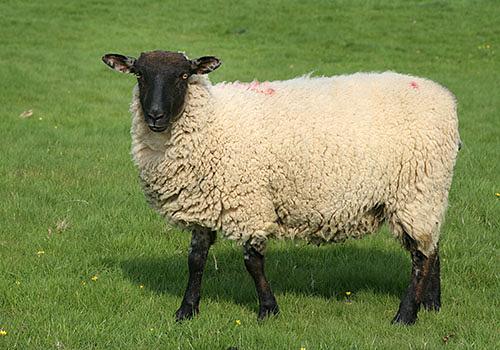Nutritional Diseases of Sheep
Sep 19, 2022

By David G. Pugh DVM, MS, at Auburn University
Nutritional diseases can be caused by specific nutrient deficiencies, excesses or imbalances, or by metabolic disturbances. Nutritional diseases in sheep are, for the most part, the same as those seen in goats.
Enterotoxemia
This feed-related malady causes almost sudden death in sheep due to a toxin produced by Clostridium perfringens type D and sometimes type C. The organism appears to be widespread. Under conditions of high carbohydrate consumption or high intake of immature succulent forage, the causative bacteria multiply rapidly and produce an ε toxin that increases intestinal permeability. Thus, diets with greater than 20% highly fermentable carbohydrates should be fed with caution. Protection of lambs is possible by vaccinating twice at least 10 days apart with C perfringens type D toxoid or by administering antitoxin at birth.
White Muscle Disease
White muscle disease is caused by low levels of selenium and possibly vitamin E. Signs include stiffness (especially in the hindquarters), tucked-up rear flanks, arched backs, pneumonia, and acute death. On necropsy, white striations are found in cardiac, diaphragmatic, and skeletal muscles. Levels of AST and lactic dehydrogenase are increased, indicating muscle damage. Blood levels of the selenium-containing glutathione peroxidase are reduced. Although several feedstuffs are rich in selenium and vitamin E, it may be a good management practice in deficient areas to inject lambs shortly after birth with the preparation of vitamin E and selenium designed for parenteral use. The use of selenium and/or vitamin E-supplemented trace mineral mixture (up to 90 ppm) as the only source of salt fed may be useful as a preventive measure.
Although the cause, prevention, and treatment of many nutritional diseases are now understood, such diseases continue to reduce profits in the long run. Your local Co-op is a great resource for all things small ruminant. Find more content like this in this month’s issue of The Cooperator.
Nutritional diseases can be caused by specific nutrient deficiencies, excesses or imbalances, or by metabolic disturbances. Nutritional diseases in sheep are, for the most part, the same as those seen in goats.
Enterotoxemia
This feed-related malady causes almost sudden death in sheep due to a toxin produced by Clostridium perfringens type D and sometimes type C. The organism appears to be widespread. Under conditions of high carbohydrate consumption or high intake of immature succulent forage, the causative bacteria multiply rapidly and produce an ε toxin that increases intestinal permeability. Thus, diets with greater than 20% highly fermentable carbohydrates should be fed with caution. Protection of lambs is possible by vaccinating twice at least 10 days apart with C perfringens type D toxoid or by administering antitoxin at birth.
White Muscle Disease
White muscle disease is caused by low levels of selenium and possibly vitamin E. Signs include stiffness (especially in the hindquarters), tucked-up rear flanks, arched backs, pneumonia, and acute death. On necropsy, white striations are found in cardiac, diaphragmatic, and skeletal muscles. Levels of AST and lactic dehydrogenase are increased, indicating muscle damage. Blood levels of the selenium-containing glutathione peroxidase are reduced. Although several feedstuffs are rich in selenium and vitamin E, it may be a good management practice in deficient areas to inject lambs shortly after birth with the preparation of vitamin E and selenium designed for parenteral use. The use of selenium and/or vitamin E-supplemented trace mineral mixture (up to 90 ppm) as the only source of salt fed may be useful as a preventive measure.
Although the cause, prevention, and treatment of many nutritional diseases are now understood, such diseases continue to reduce profits in the long run. Your local Co-op is a great resource for all things small ruminant. Find more content like this in this month’s issue of The Cooperator.